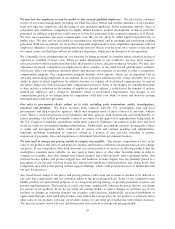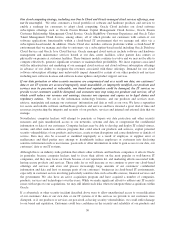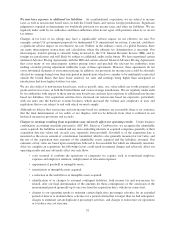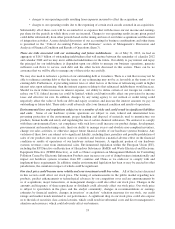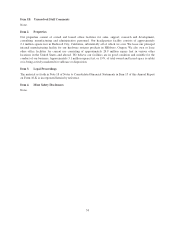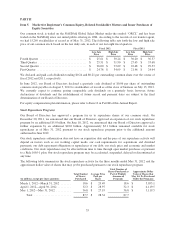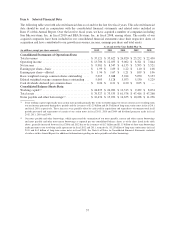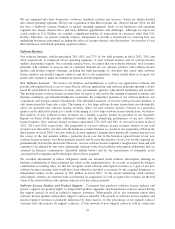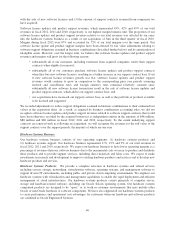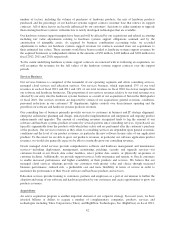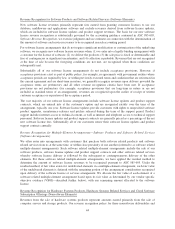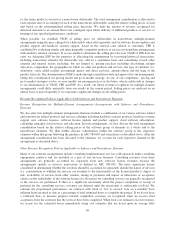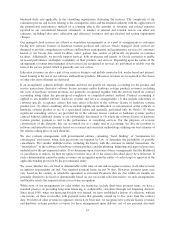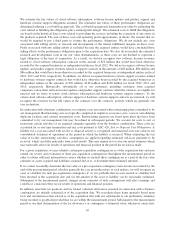Oracle 2012 Annual Report Download - page 43
Download and view the complete annual report
Please find page 43 of the 2012 Oracle annual report below. You can navigate through the pages in the report by either clicking on the pages listed below, or by using the keyword search tool below to find specific information within the annual report.
We are organized into three businesses—software, hardware systems and services—which are further divided
into certain operating segments. Prior to our acquisition of Sun Microsystems, Inc. (Sun) in January 2010, we did
not have a hardware systems business or related operating segments. Each of our businesses and operating
segments has unique characteristics and faces different opportunities and challenges. Although we report our
actual results in U.S. Dollars, we conduct a significant number of transactions in currencies other than U.S.
Dollars. Therefore, we present constant currency information to provide a framework for assessing how our
underlying businesses performed excluding the effect of foreign currency rate fluctuations. An overview of our
three businesses and related operating segments follows.
Software Business
Our software business, which represented 70%, 68% and 77% of our total revenues in fiscal 2012, 2011 and
2010, respectively, is comprised of two operating segments: (1) new software licenses and (2) software license
updates and product support. On a constant currency basis, we expect that our software business’ total revenues
generally will continue to increase due to continued demand for our software products and software license
updates and product support offerings, including the high percentage of customers that renew their software
license updates and product support contracts and due to our acquisitions, which should allow us to grow our
profits and continue to make investments in research and development.
New Software Licenses: We license our database and middleware as well as our applications software and
provide subscription-based access to select Oracle software applications and software platforms through a cloud-
based IT environment to businesses of many sizes, government agencies, educational institutions and resellers.
The growth in new software license revenues that we report is affected by the strength of general economic and
business conditions, governmental budgetary constraints, the competitive position of our software products, our
acquisitions and foreign currency fluctuations. The substantial majority of our new software license business is
also characterized by long sales cycles. The timing of a few large software license transactions can substantially
affect our quarterly new software license revenues. Since our new software license revenues in a particular
quarter can be difficult to predict as a result of the timing of a few large software license transactions, we believe
that analysis of new software license revenues on a trailing 4-quarter period (as provided in our Quarterly
Reports on Form 10-Q) provides additional visibility into the underlying performance of our new software
license business. New software license revenues represented 27%, 26% and 28% of our total revenues in fiscal
2012, 2011 and 2010, respectively. The proportion of our new software license revenues relative to our total
revenues was affected by our entry into the hardware systems business as a result of our acquisition of Sun in the
third quarter of fiscal 2010. Our new software license segment’s margins have historically trended upward over
the course of the four quarters within a particular fiscal year due to the historical upward trend of our new
software license revenues over those quarterly periods and because the majority of our costs for this segment are
predominantly fixed in the short-term. However, our new software license segment’s margins have been and will
continue to be affected by fair value adjustments relating to the cloud software subscription obligations that we
assumed in business combinations (described further below) and by the amortization of intangible assets
associated with companies and technologies that we have acquired.
We recorded adjustments to reduce obligations under our assumed cloud software subscription offerings in
business combinations to their estimated fair values at the acquisition dates. As a result, as required by business
combination accounting rules, we did not recognize cloud software subscription revenues as a part of our new
software licenses revenues that would have been otherwise recorded as revenues by the acquired businesses as
independent entities in the amount of $22 million in fiscal 2012. To the extent underlying cloud software
subscription contracts are renewed with us following an acquisition, we will recognize the revenues for the full
value of the cloud software subscription contracts over the contract periods.
Software License Updates and Product Support: Customers that purchase software license updates and
product support are granted rights to unspecified product upgrades and maintenance releases issued during
the support period, as well as technical support assistance. Substantially all of our customers renew their
software license updates and product support contracts annually. The growth of software license updates and
product support revenues is primarily influenced by three factors: (1) the percentage of our support contract
customer base that renews its support contracts, (2) the amount of new support contracts sold in connection
39


